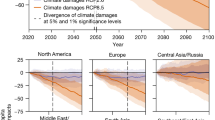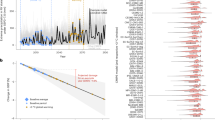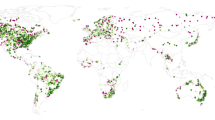Abstract
In response to rising water scarcity concerns around the world, water utilities are expanding and diversifying their water supply portfolios, including attempting to value and reuse every drop throughout the water cycle. This transition is creating new hybrid infrastructure systems that combine centralized and decentralized sources at various scales. To help strategize and manage these emerging hybrid systems, we introduce a flexible goal-based water-trading framework using a combination of regulatory and market incentives. We apply this framework in a simulation of the San Francisco Bay Area, and test the effects of policy parameters, local preferences and collaboration between utilities. Results show that the option of engaging in an open trading scheme can lead to a more strategic and holistic path to higher regional resiliency through increased diversity in water portfolios, at lower costs than if utilities were tasked with pursuing goals independently. Highest benefits are observed when utilities cooperate in the exchange of information, which highlights the importance of transparency and trust operating in conjunction with regulatory and market forces.
This is a preview of subscription content, access via your institution
Access options
Access Nature and 54 other Nature Portfolio journals
Get Nature+, our best-value online-access subscription
$29.99 / 30 days
cancel any time
Subscribe to this journal
Receive 12 digital issues and online access to articles
$119.00 per year
only $9.92 per issue
Buy this article
- Purchase on Springer Link
- Instant access to full article PDF
Prices may be subject to local taxes which are calculated during checkout






Similar content being viewed by others
Data availability
The data that support the findings of this study are available within the paper and its Supplementary Information files.
References
Diffenbaugh, N. S., Swain, D. L. & Touma, D. Anthropogenic warming has increased drought risk in California. Proc. Natl Acad. Sci. USA 112, 3931–3936 (2015).
Quesnel, K. J. & Ajami, N. K. Changes in water consumption linked to heavy news media coverage of extreme climatic events. Sci. Adv. 3, e1700784 (2017).
Gonzales, P. & Ajami, N. Social and structural patterns of drought-related water conservation and rebound. Water Resour. Res. 53, 10619–10634 (2017).
Viviroli, D. et al. Climate change and mountain water resources: overview and recommendations for research, management and policy. Hydrol. Earth Syst. Sci. 15, 471–504 (2011).
Hering, J. G., Waite, T. D., Luthy, R. G., Drewes, J. E. & Sedlak, D. L. A changing framework for urban water systems. Environ. Sci. Technol. 47, 10721–10726 (2013).
Beh, E. H. Y., Maier, H. R. & Dandy, G. C. Adaptive, multiobjective optimal sequencing approach for urban water supply augmentation under deep uncertainty. Water Resour. Res. 51, 1529–1551 (2015).
Porse, E. et al. Systems analysis and optimization of local water supplies in Los Angeles. J. Water Resour. Plan. Manage. 143, 04017049 (2017).
Low, K. et al. Fighting drought with innovation: Melbourne’s response to the Millennium Drought in Southeast Australia. WIREs Water 2, 315–328 (2015).
US Water Alliance One Water Roadmap: The Sustainable Management of Life’s Most Essential Resource (2016); http://uswateralliance.org/sites/uswateralliance.org/files/publications/Roadmap%20FINAL.pdf
Mukheibir, P., Howe, C. & Gallet, D. What’s getting in the way of a One Water approach to water services planning and management? Water 41, 67–73 (2014).
Pahl-Wostl, C. et al. Managing change toward adaptive water management through social learning. Ecol. Soc. 12, 30 (2007).
Aerts, J. C. J. H., Botzen, W., van der Veen, A., Krywkow, J. & Werners, S. Dealing with uncertainty in flood management through diversification. Ecol. Soc. 13, 41 (2008).
Kiparsky, M., Sedlak, D. L., Thompson, B. H. & Truffer, B. The innovation deficit in urban water: the need for an integrated perspective on institutions, organizations, and technology. Environ. Eng. Sci. 30, 395–408 (2013).
Marston, L. & Cai, X. An overview of water reallocation and the barriers to its implementation. WIREs Water 3, 658–677 (2016).
Mayr, D., Schmidt, J. & Schmid, E. The potentials of a reverse auction in allocating subsidies for cost-effective roof-top photovoltaic system deployment. Energy Policy 69, 555–565 (2014).
Thurston, H. W., Taylor, M. A., Shuster, W. D., Roy, A. H. & Morrison, M. A. Using a reverse auction to promote household level stormwater control. Environ. Sci. Policy 13, 405–414 (2010).
Taylor, M. R. Innovation under cap-and-trade programs. Proc. Natl Acad. Sci. USA 109, 4804–4809 (2012).
Rahimova, N., Hesseln, H. & Silven, P. Factors affecting water market acceptance: a case study of stakeholders in southern Alberta, Canada. Can. Geogr. 60, 245–258 (2016).
Izadpanah, H., Yousefi, G. R. & Makhdoumi Kaviri, S. Asset and risk management for a wind farm in a competitive electricity market. In 21st Iranian Conference on Electrical Engineering (IEEE, 2013).
Rogge, K. S., Schneider, M. & Hoffmann, V. H. The innovation impact of the EU Emission Trading System—findings of company case studies in the German power sector. Ecol. Econ. 70, 513–523 (2011).
Stern, J. Introducing competition into England and Wales water industry—lessons from UK and EU energy market liberalisation. Util. Policy 18, 120–128 (2010).
Espey, S. Renewables portfolio standard: a means for trade with electricity from renewable energy sources? Energy Policy 29, 557–566 (2001).
Morthorst, P. E. The development of a green certificate market. Energy Policy 28, 1085–1094 (2000).
Gonzales, P. & Ajami, N. K. The changing water cycle: impacts of an evolving supply and demand landscape on urban water reliability in the Bay Area. WIREs Water 4, e1240 (2017).
Brozovic, N., Sunding, D. L. & Zilberman, D. Estimating business and residential water supply interruption losses from catastrophic events. Water Resour. Res. 43, W08423 (2007).
Kwon, T.-h Rent and rent-seeking in renewable energy support policies: feed-in tariff vs. renewable portfolio standard. Renew. Sustain. Energy Rev. 44, 676–681 (2015).
BenDor, T. K., Riggsbee, J. A. & Doyle, M. Risk and markets for ecosystem services. Environ. Sci. Technol. 45, 10322–10330 (2011).
Morris, E. K. et al. Choosing and using diversity indices: insights for ecological applications from the German Biodiversity Exploratories. Ecol. Evol. 4, 3514–3524 (2014).
Van Beers, C. & Zand, F. R&D cooperation, partner diversity, and innovation performance: an empirical analysis. J. Prod. Innovat. Manag. 31, 292–312 (2014).
Gonzales, P. & Ajami, N. K. An integrative regional resilience framework for the changing urban water paradigm. Sustain. Cities Soc. 30, 128–138 (2017).
Palazzo, J. et al. Urban responses to restrictive conservation policy during drought. Water Resour. Res. 53, 4459–4475 (2017).
Mika, K. et al. LA Sustainable Water Project: Los Angeles City-Wide Overview (UCLA Institute of the Environment and Sustainability, UCLA Sustainable LA Grand Challenges & Colorado School of Mines, 2018).
Porse, E. et al. The economic value of local water supplies in Los Angeles. Nat. Sustain. 1, 289–297 (2018).
National Research Council Adaptive Management for Water Resources Project Planning (The National Academies Press, Washington DC, 2004).
Aerts, J. C. J. H. et al. Integrating human behaviour dynamics into flood disaster risk assessment. Nat. Clim. Change 8, 193–199 (2018).
Ostrom, E. Polycentric systems for coping with collective action and global environmental change. Glob. Environ. Change 20, 550–557 (2010).
Hughes, S. & Pincetl, S. Evaluating collaborative institutions in context: the case of regional water management in southern California. Environ. Plan. C 32, 20–38 (2014).
Gonzales, P., Ajami, N. & Sun, Y. Coordinating water conservation efforts through tradable credits: a proof of concept for drought response in the San Francisco Bay area. Water Resour. Res. 53, 7662–7677 (2017).
Madani, K. & Dinar, A. Cooperative institutions for sustainable common pool resource management: application to groundwater. Water Resour. Res. 48, W09553 (2012).
Doyle, M. W., Patterson, L. A., Chen, Y., Schnier, K. E. & Yates, A. J. Optimizing the scale of markets for water quality trading. Water Resour. Res. 50, 7231–7244 (2014).
Mora, D. et al. Auctions for Renewable Energy Support—Taming the Beast of Competitive Bidding (AURES, 2017); http://auresproject.eu/publications/auctions-renewable-energy-support-taming-the-beast-of-competitive-bidding
Nay, J. J., Abkowitz, M., Chu, E., Gallagher, D. & Wright, H. A review of decision-support models for adaptation to climate change in the context of development. Clim. Dev. 6, 357–367 (2014).
Haer, T., Botzen, W. J. W., Moel, H. & Aerts, J. C. J. H. Integrating household risk mitigation behavior in flood risk analysis: an agent-based model approach. Risk. Anal. 37, 1977–1992 (2016).
Ali, A. M., Shafiee, M. E. & Berglund, E. Z. Agent-based modeling to simulate the dynamics of urban water supply: climate, population growth, and water shortages. Sustain. Cities Soc. 28, 420–434 (2017).
Bonabeau, E. Agent-based modeling: methods and techniques for simulating human systems. Proc. Natl Acad. Sci. USA 99, 7280–7287 (2002).
Lempert, R. Agent-based modeling as organizational and public policy simulators. Proc. Natl Acad. Sci. USA 99, 7195–7196 (2002).
Ritzenhofen, I., Birge, J. R. & Spinler, S. The structural impact of renewable portfolio standards and feed-in tariffs on electricity markets. Eur. J. Oper. Res. 255, 224–242 (2016).
Wu, W. Y. et al. Including stakeholder input in formulating and solving real-world optimisation problems: generic framework and case study. Environ. Model. Softw. 79, 197–213 (2016).
Novacheck, J. & Johnson, J. X. The environmental and cost implications of solar energy preferences in Renewable Portfolio Standards. Energy Policy 86, 250–261 (2015).
Cliff, D. & Bruten, J. Less than human: simple adaptive trading agents for CDA markets. IFAC Proc. Vol. 31, 117–122 (1998).
Du, E., Cai, X., Brozović, N. & Minsker, B. Evaluating the impacts of farmers’ behaviors on a hypothetical agricultural water market based on double auction. Water Resour. Res. 53, 4053–4072 (2017).
Hajkowicz, S. & Collins, K. A review of multiple criteria analysis for water resource planning and management. Water Resour. Manag. 21, 1553–1566 (2007).
Giuliani, M. & Castelletti, A. Assessing the value of cooperation and information exchange in large water resources systems by agent-based optimization. Water Resour. Res. 49, 3912–3926 (2013).
Acknowledgements
We appreciate the partnership with Sonoma County Water Agency on this project, especially C. Pollard and J. Jasperse for their continuous support and constructive feedback. We also thank K. Quesnel, P. Bolorinos and P. Womble for providing useful suggestions and technical guidance that improved this paper. This work was financially supported by Sonoma County Water Agency and the National Science Foundation Engineering Research Center for Re-Inventing the Nation’s Urban Water Infrastructure (award number EEC-1028968). Any opinions, findings and conclusions or recommendations expressed in this material are those of the authors and do not necessarily reflect the views of Sonoma County Water Agency or the National Science Foundation. This work was completed at Stanford University as part of P.G.’s PhD dissertation.
Author information
Authors and Affiliations
Contributions
P.G. and N.K.A. designed the study. P.G. performed the modelling work. P.G. and N.K.A. analysed the results and wrote the manuscript.
Corresponding author
Ethics declarations
Competing interests
The authors declare no competing interests.
Additional information
Publisher’s note: Springer Nature remains neutral with regard to jurisdictional claims in published maps and institutional affiliations.
Supplementary information
Supplementary Information
Supplementary Methods, Supplementary Figures 1–6, Supplementary Tables 1–2, Supplementary References 1–24
Rights and permissions
About this article
Cite this article
Gonzales, P., Ajami, N.K. Goal-based water trading expands and diversifies supplies for enhanced resilience. Nat Sustain 2, 138–147 (2019). https://doi.org/10.1038/s41893-019-0228-z
Received:
Accepted:
Published:
Issue Date:
DOI: https://doi.org/10.1038/s41893-019-0228-z



